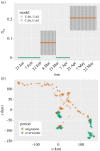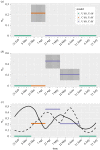Disentangling social interactions and environmental drivers in multi-individual wildlife tracking data
- PMID: 29581392
- PMCID: PMC5882977
- DOI: 10.1098/rstb.2017.0007
Disentangling social interactions and environmental drivers in multi-individual wildlife tracking data
Abstract
While many animal species exhibit strong conspecific interactions, movement analyses of wildlife tracking datasets still largely focus on single individuals. Multi-individual wildlife tracking studies provide new opportunities to explore how individuals move relative to one another, but such datasets are frequently too sparse for the detailed, acceleration-based analytical methods typically employed in collective motion studies. Here, we address the methodological gap between wildlife tracking data and collective motion by developing a general method for quantifying movement correlation from sparsely sampled data. Unlike most existing techniques for studying the non-independence of individual movements with wildlife tracking data, our approach is derived from an analytically tractable stochastic model of correlated movement. Our approach partitions correlation into a deterministic tendency to move in the same direction termed 'drift correlation' and a stochastic component called 'diffusive correlation'. These components suggest the mechanisms that coordinate movements, with drift correlation indicating external influences, and diffusive correlation pointing to social interactions. We use two case studies to highlight the ability of our approach both to quantify correlated movements in tracking data and to suggest the mechanisms that generate the correlation. First, we use an abrupt change in movement correlation to pinpoint the onset of spring migration in barren-ground caribou. Second, we show how spatial proximity mediates intermittently correlated movements among khulans in the Gobi desert. We conclude by discussing the linkages of our approach to the theory of collective motion.This article is part of the theme issue 'Collective movement ecology'.
Keywords: caribou; correlated diffusion; khulan; movement correlation indices; shared drift; wildlife tracking data.
© 2018 The Author(s).
Conflict of interest statement
We declare we have no competing interests.
Figures




References
Publication types
MeSH terms
Associated data
LinkOut - more resources
Full Text Sources
Other Literature Sources
Miscellaneous

